warning SKODA OCTAVIA 2011 2.G / (1Z) Workshop Manual
[x] Cancel search | Manufacturer: SKODA, Model Year: 2011, Model line: OCTAVIA, Model: SKODA OCTAVIA 2011 2.G / (1Z)Pages: 248, PDF Size: 3.79 MB
Page 69 of 248

–
Distribute the items of luggage as evenly as possible.
– Place heavy objects as far forward as possible.
– Attach the items of luggage to the lashing eyes or the fixing net ⇒ page 67.
In the event of an accident, there is such a high kinetic energy which is produced
by small and light objects that they can cause severe injuries. The magnitude of
the kinetic energy depends on the speed at which the vehicle is travelling and on
the weight of the object. The speed at which the vehicle is travelling is in this case
the more significant factor.
Example: In the event of a frontal collision at a speed of 50 km/h, an unsecured
object with a weight of 4.5 kg produces an energy, which corresponds to 20 times
its own weight. This means that it results in a weight of approx. 90 kg. You can
imagine the injuries that can occur, if this
“bullet” is flying through the interior
compartment and hits an occupant. WARNING
● Store the objects in the luggage compartment and attach them to the
lashing eyes.
● Loose objects in the passenger compartment can be thrown forward dur-
ing a sudden manoeuvre or in case of an accident and can injure the occupants
or other oncoming traffic. This risk is still increased, if the objects which are
flying around are hit by a deployed airbag. In this case, the objects which are
thrown back can injure the occupants - hazard.
● Please note that the handling properties of your vehicle may be affected
when transporting heavy objects as a result of the displacement of the centre
of gravity. The speed and style of driving must be adjusted accordingly.
● The items carried in the luggage compartment should be stored in such a
way that no objects are able to slip forward if there are any sudden driving or
braking manoeuvres undertaken - risk of injury!
● Never drive with the boot lid fully opened or slightly ajar otherwise ex-
haust gases may get into the interior of the vehicle - risk of poisoning!
● On no account exceed the permissible axle loads and the permissible gross
weight of the vehicle - risk of accident!
● Never transport occupants in the luggage compartment! CAUTION
Make sure that transported objects with sharp edges do not damage the follow-
ing:
● heating elements in the rear window,
● elements of the aerial integrated in the rear window (Octavia),
● elements of the aerial integrated in the rear side windows (Estate car). Note
Tyre pressure must be adjusted to the load ⇒ page 192
.
Vehicles of category N1 On vehicles of the category N1, which are not fitted with a protective grille, a lash-
ing set which complies with the standard EN
12195 (1 - 4) must be used for fasten-
ing the load.
Lashing eyes Fig. 52 Luggage compartment: Lashing eyes Octavia/Estate car
Eyes are located on the sides of the luggage compartment for lashing the goods
to be loaded.
You can also attach a floor fixing net to these eyes for holding small objects.
The floor fixing net and the installation instruction are located in a container un-
der the floor covering of the luggage compartment behind the spare wheel. £ 67
Seats and Stowage Using the system Safety Driving Tips General Maintenance Breakdown assistance Technical data
Page 70 of 248
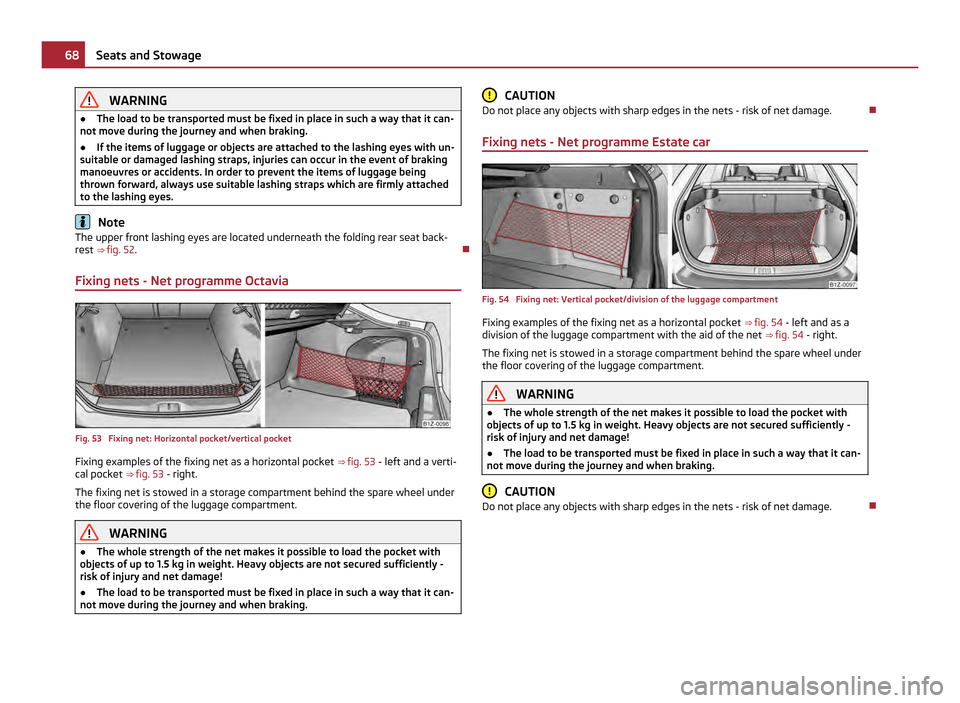
WARNING
● The load to be transported must be fixed in place in such a way that it can-
not move during the journey and when braking.
● If the items of luggage or objects are attached to the lashing eyes with un-
suitable or damaged lashing straps, injuries can occur in the event of braking
manoeuvres or accidents. In order to prevent the items of luggage being
thrown forward, always use suitable lashing straps which are firmly attached
to the lashing eyes. Note
The upper front lashing eyes are located underneath the folding rear seat back-
rest ⇒
fig. 52.
Fixing nets - Net programme Octavia Fig. 53 Fixing net: Horizontal pocket/vertical pocket
Fixing examples of the fixing net as a horizontal pocket
⇒ fig. 53
- left and a verti-
cal pocket ⇒ fig. 53 - right.
The fixing net is stowed in a storage compartment behind the spare wheel under
the floor covering of the luggage compartment. WARNING
● The whole strength of the net makes it possible to load the pocket with
objects of up to 1.5 kg in weight. Heavy objects are not secured sufficiently -
risk of injury and net damage!
● The load to be transported must be fixed in place in such a way that it can-
not move during the journey and when braking. CAUTION
Do not place any objects with sharp edges in the nets - risk of net damage.
Fixing nets - Net programme Estate car Fig. 54 Fixing net: Vertical pocket/division of the luggage compartment
Fixing examples of the fixing net as a horizontal pocket
⇒ fig. 54 - left and as a
division of the luggage compartment with the aid of the net ⇒ fig. 54 - right.
The fixing net is stowed in a storage compartment behind the spare wheel under
the floor covering of the luggage compartment. WARNING
● The whole strength of the net makes it possible to load the pocket with
objects of up to 1.5 kg in weight. Heavy objects are not secured sufficiently -
risk of injury and net damage!
● The load to be transported must be fixed in place in such a way that it can-
not move during the journey and when braking. CAUTION
Do not place any objects with sharp edges in the nets - risk of net damage. 68
Seats and Stowage
Page 71 of 248
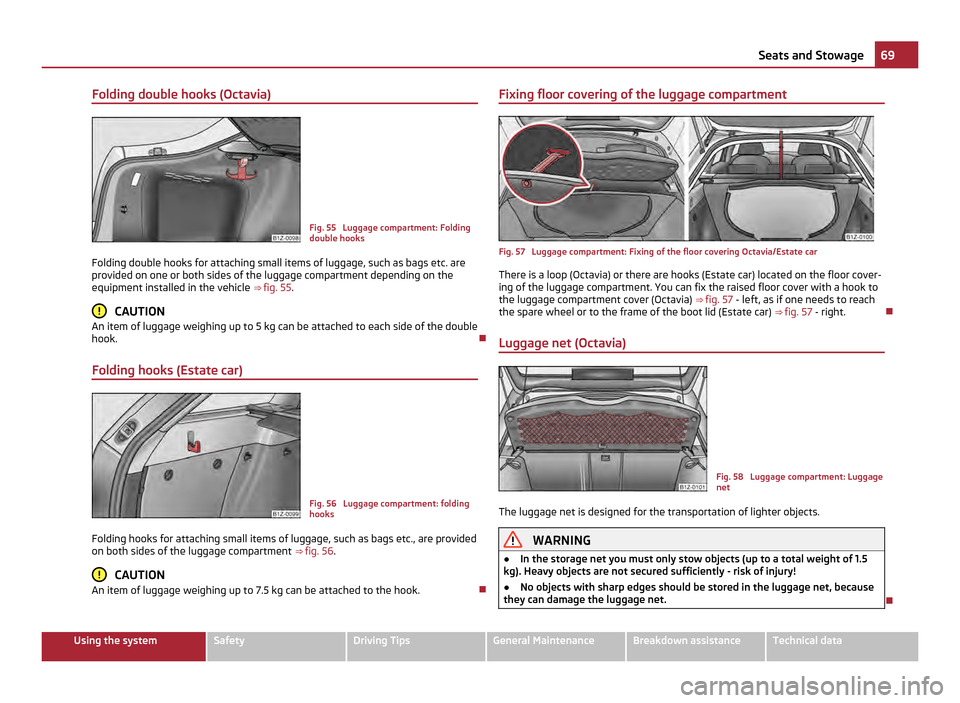
Folding double hooks (Octavia)
Fig. 55 Luggage compartment: Folding
double hooks
Folding double hooks for attaching small items of luggage, such as bags etc. are
provided on one or both sides of the luggage compartment depending on the
equipment installed in the vehicle ⇒
fig. 55. CAUTION
An item of luggage weighing up to 5 kg can be attached to each side of the double
hook.
Folding hooks (Estate car) Fig. 56 Luggage compartment: folding
hooks
Folding hooks for attaching small items of luggage, such as bags etc., are provided
on both sides of the luggage compartment ⇒ fig. 56 . CAUTION
An item of luggage weighing up to 7.5 kg can be attached to the hook. Fixing floor covering of the luggage compartment
Fig. 57 Luggage compartment: Fixing of the floor covering Octavia/Estate car
There is a loop (Octavia) or there are hooks (Estate car) located on the floor cover-
ing of the luggage compartment. You can fix the raised floor cover with a hook to
the luggage compartment cover (Octavia) ⇒ fig. 57 - left, as if one needs to reach
the spare wheel or to the frame of the boot lid (Estate car) ⇒
fig. 57 - right.
Luggage net (Octavia) Fig. 58 Luggage compartment: Luggage
net
The luggage net is designed for the transportation of lighter objects. WARNING
● In the storage net you must only stow objects (up to a total weight of 1.5
kg). Heavy objects are not secured sufficiently - risk of injury!
● No objects with sharp edges should be stored in the luggage net, because
they can damage the luggage net. 69
Seats and Stowage Using the system Safety Driving Tips General Maintenance Breakdown assistance Technical data
Page 72 of 248
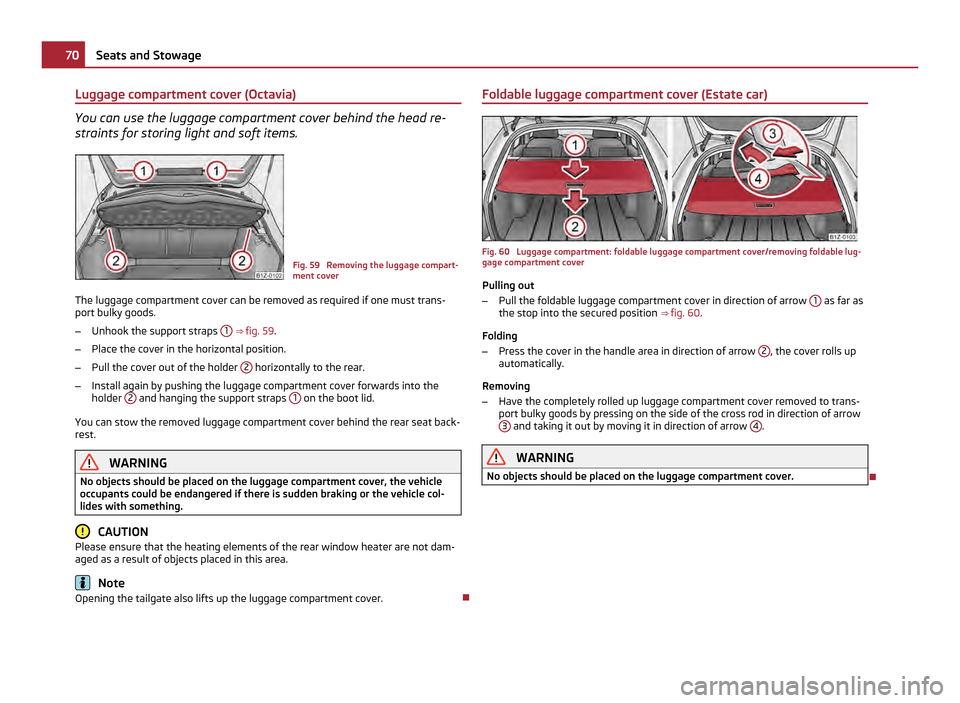
Luggage compartment cover (Octavia)
You can use the luggage compartment cover behind the head re-
straints for storing light and soft items.
Fig. 59 Removing the luggage compart-
ment cover
The luggage compartment cover can be removed as required if one must trans-
port bulky goods.
– Unhook the support straps 1
⇒ fig. 59 .
– Place the cover in the horizontal position.
– Pull the cover out of the holder 2 horizontally to the rear.
– Install again by pushing the luggage compartment cover forwards into the
holder 2 and hanging the support straps
1 on the boot lid.
You can stow the removed luggage compartment cover behind the rear seat back-
rest. WARNING
No objects should be placed on the luggage compartment cover, the vehicle
occupants could be endangered if there is sudden braking or the vehicle col-
lides with something. CAUTION
Please ensure that the heating elements of the rear window heater are not dam-
aged as a result of objects placed in this area. Note
Opening the tailgate also lifts up the luggage compartment cover. Foldable luggage compartment cover (Estate car)
Fig. 60 Luggage compartment: foldable luggage compartment cover/removing foldable lug-
gage compartment cover
Pulling out
– Pull the foldable luggage compartment cover in direction of arrow 1 as far as
the stop into the secured position ⇒ fig. 60 .
Folding
– Press the cover in the handle area in direction of arrow 2 , the cover rolls up
automatically.
Removing
– Have the completely rolled up luggage compartment cover removed to trans-
port bulky goods by pressing on the side of the cross rod in direction of arrow 3 and taking it out by moving it in direction of arrow
4 .
WARNING
No objects should be placed on the luggage compartment cover. 70
Seats and Stowage
Page 73 of 248
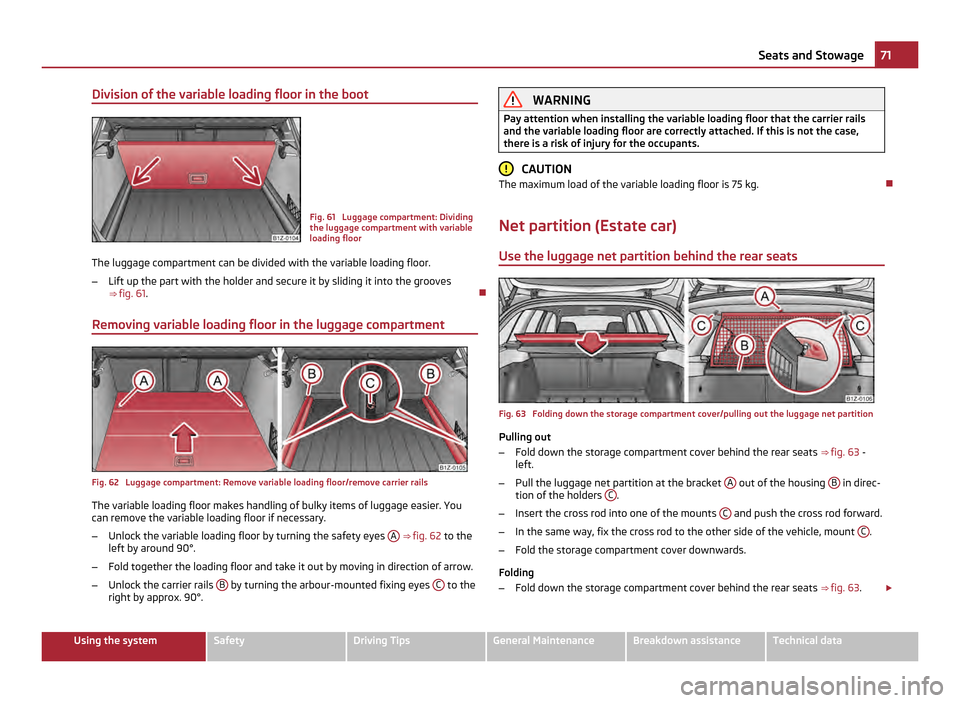
Division of the variable loading floor in the boot
Fig. 61 Luggage compartment: Dividing
the luggage compartment with variable
loading floor
The luggage compartment can be divided with the variable loading floor.
– Lift up the part with the holder and secure it by sliding it into the grooves
⇒ fig. 61 .
Removing variable loading floor in the luggage compartment Fig. 62 Luggage compartment: Remove variable loading floor/remove carrier rails
The variable loading floor makes handling of bulky items of luggage easier. You
can remove the variable loading floor if necessary.
–
Unlock the variable loading floor by turning the safety eyes A
⇒ fig. 62 to the
left by around 90°.
– Fold together the loading floor and take it out by moving in direction of arrow.
– Unlock the carrier rails B by turning the arbour-mounted fixing eyes
C to the
right by approx. 90°. WARNING
Pay attention when installing the variable loading floor that the carrier rails
and the variable loading floor are correctly attached. If this is not the case,
there is a risk of injury for the occupants. CAUTION
The maximum load of the variable loading floor is 75 kg.
Net partition (Estate car) Use the luggage net partition behind the rear seats Fig. 63 Folding down the storage compartment cover/pulling out the luggage net partition
Pulling out
– Fold down the storage compartment cover behind the rear seats
⇒ fig. 63
-
left.
– Pull the luggage net partition at the bracket A out of the housing
B in direc-
tion of the holders C .
– Insert the cross rod into one of the mounts C and push the cross rod forward.
– In the same way, fix the cross rod to the other side of the vehicle, mount C .
– Fold the storage compartment cover downwards.
Folding
– Fold down the storage compartment cover behind the rear seats ⇒ fig. 63 .£ 71
Seats and Stowage Using the system Safety Driving Tips General Maintenance Breakdown assistance Technical data
Page 74 of 248
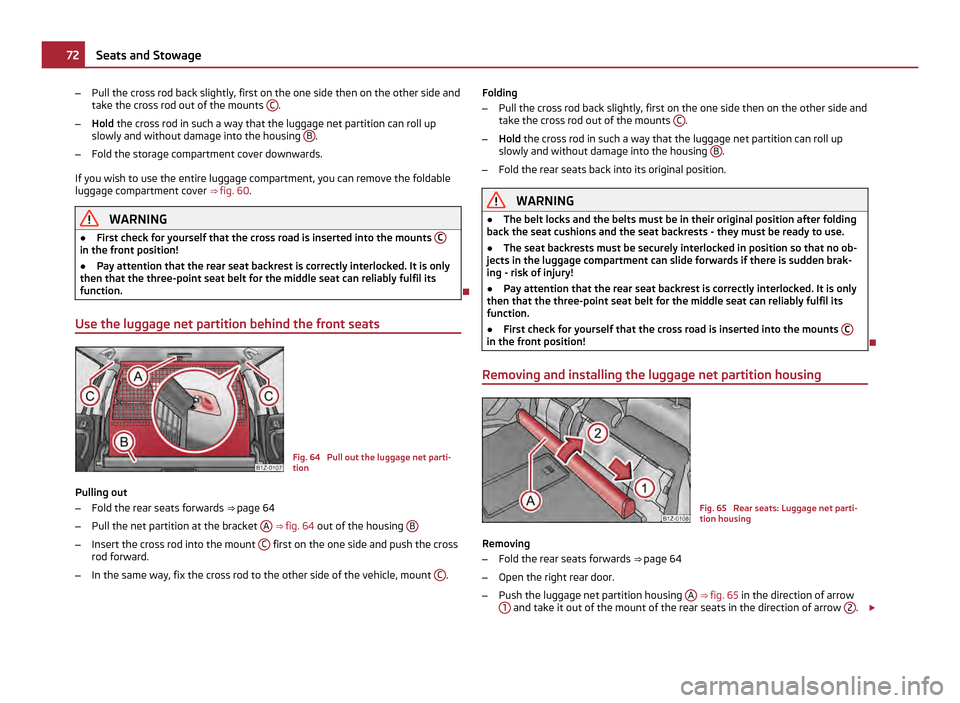
–
Pull the cross rod back slightly, first on the one side then on the other side and
take the cross rod out of the mounts C .
– Hold the cross rod in such a way that the luggage net partition can roll up
slowly and without damage into the housing B .
– Fold the storage compartment cover downwards.
If you wish to use the entire luggage compartment, you can remove the foldable
luggage compartment cover ⇒
fig. 60 . WARNING
● First check for yourself that the cross road is inserted into the mounts Cin the front position!
●
Pay attention that the rear seat backrest is correctly interlocked. It is only
then that the three-point seat belt for the middle seat can reliably fulfil its
function.
Use the luggage net partition behind the front seats Fig. 64 Pull out the luggage net parti-
tion
Pulling out
– Fold the rear seats forwards ⇒ page 64
– Pull the net partition at the bracket A
⇒ fig. 64 out of the housing B–
Insert the cross rod into the mount C first on the one side and push the cross
rod forward.
– In the same way, fix the cross rod to the other side of the vehicle, mount C .Folding
–
Pull the cross rod back slightly, first on the one side then on the other side and
take the cross rod out of the mounts C .
– Hold the cross rod in such a way that the luggage net partition can roll up
slowly and without damage into the housing B .
– Fold the rear seats back into its original position. WARNING
● The belt locks and the belts must be in their original position after folding
back the seat cushions and the seat backrests - they must be ready to use.
● The seat backrests must be securely interlocked in position so that no ob-
jects in the luggage compartment can slide forwards if there is sudden brak-
ing - risk of injury!
● Pay attention that the rear seat backrest is correctly interlocked. It is only
then that the three-point seat belt for the middle seat can reliably fulfil its
function.
● First check for yourself that the cross road is inserted into the mounts C in the front position!
Removing and installing the luggage net partition housing Fig. 65 Rear seats: Luggage net parti-
tion housing
Removing
– Fold the rear seats forwards ⇒ page 64
– Open the right rear door.
– Push the luggage net partition housing A
⇒
fig. 65 in the direction of arrow
1 and take it out of the mount of the rear seats in the direction of arrow
2 .
£ 72
Seats and Stowage
Page 75 of 248
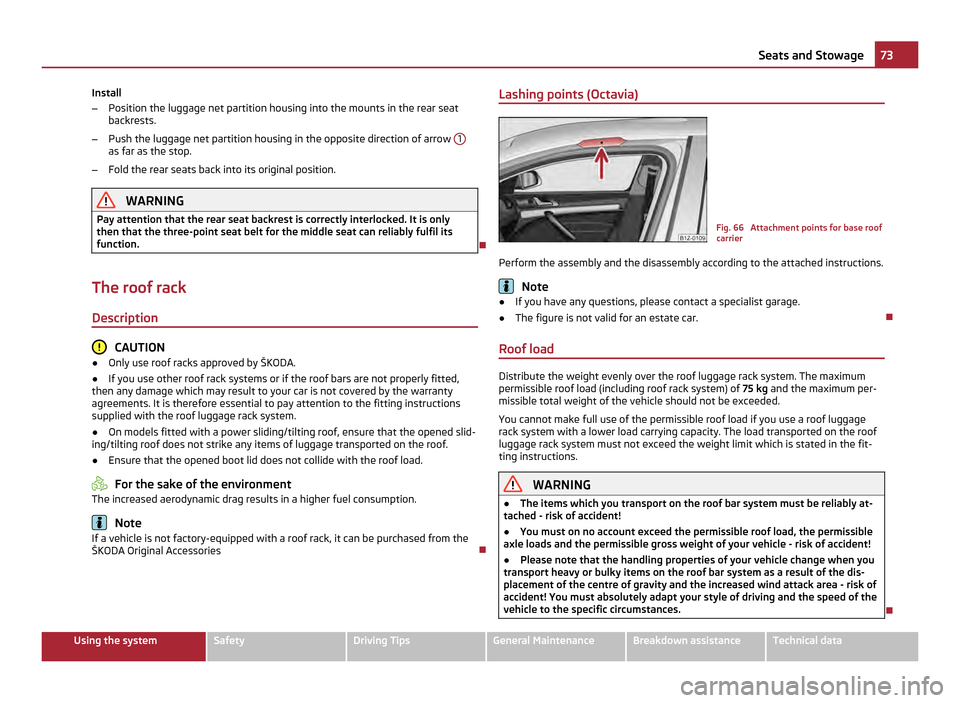
Install
–
Position the luggage net partition housing into the mounts in the rear seat
backrests.
– Push the luggage net partition housing in the opposite direction of arrow 1as far as the stop.
– Fold the rear seats back into its original position. WARNING
Pay attention that the rear seat backrest is correctly interlocked. It is only
then that the three-point seat belt for the middle seat can reliably fulfil its
function.
The roof rack Description CAUTION
● Only use roof racks approved by ŠKODA.
● If you use other roof rack systems or if the roof bars are not properly fitted,
then any damage which may result to your car is not covered by the warranty
agreements. It is therefore essential to pay attention to the fitting instructions
supplied with the roof luggage rack system.
● On models fitted with a power sliding/tilting roof, ensure that the opened slid-
ing/tilting roof does not strike any items of luggage transported on the roof.
● Ensure that the opened boot lid does not collide with the roof load. For the sake of the environment
The increased aerodynamic drag results in a higher fuel consumption. Note
If a vehicle is not factory-equipped with a roof rack, it can be purchased from the
ŠKODA Original Accessories Lashing points (Octavia)
Fig. 66 Attachment points for base roof
carrier
Perform the assembly and the disassembly according to the attached instructions. Note
● If you have any questions, please contact a specialist garage.
● The figure is not valid for an estate car.
Roof load Distribute the weight evenly over the roof luggage rack system. The maximum
permissible roof load (including roof rack system) of
75 kg and the maximum per-
missible total weight of the vehicle should not be exceeded.
You cannot make full use of the permissible roof load if you use a roof luggage
rack system with a lower load carrying capacity. The load transported on the roof
luggage rack system must not exceed the weight limit which is stated in the fit-
ting instructions. WARNING
● The items which you transport on the roof bar system must be reliably at-
tached - risk of accident!
● You must on no account exceed the permissible roof load, the permissible
axle loads and the permissible gross weight of your vehicle - risk of accident!
● Please note that the handling properties of your vehicle change when you
transport heavy or bulky items on the roof bar system as a result of the dis-
placement of the centre of gravity and the increased wind attack area - risk of
accident! You must absolutely adapt your style of driving and the speed of the
vehicle to the specific circumstances. 73
Seats and Stowage Using the system Safety Driving Tips General Maintenance Breakdown assistance Technical data
Page 76 of 248

Cup holder
Cup holder in front centre console Fig. 67 Front centre console: Cup holder
You can place two cups or beverage cans into the recesses ⇒ fig. 67. WARNING
● Do not place any hot beverages into the cup holder. If the vehicle moves,
they may spill - risk of scalding!
● Do not use any cups or beakers which are made of brittle material (e.g.
glass, porcelain). This could lead to injuries in the event of an accident. CAUTION
Do not open the beverages in the cup holder while driving. There is a risk of spill-
ing e.g. when braking and therefore the electrical components or the seat uphols-
tery can be damaged. Cup holder in rear centre console Fig. 68 Centre console at rear: Cup
holder
– Press on the panel in the area A
⇒
fig. 68 - the cup holder comes out.
– Pull the cup holder out as far as the stop.
– Adjust the cup holder by moving the locking plate B .
WARNING
● Do not place any hot beverages into the cup holder. If the vehicle moves,
they may spill - risk of scalding!
● Do not use any cups or beakers which are made of brittle material (e.g.
glass, porcelain). This could lead to injuries in the event of an accident. CAUTION
Do not open the beverages in the cup holder while driving. They may spill when
braking and while doing so damage the vehicle. 74
Seats and Stowage
Page 77 of 248

Note holder
Fig. 69 Windscreen: Note holder
The parking ticket holder is designed e.g. for attaching a car park ticket in parking
areas.
The attached note has to always be removed before starting off in order not to
restrict the driver's vision.
Ashtray Front ashtray Fig. 70 Centre console: Front ashtray/remove front ashtray insert
Opening ashtray
– Press on the bottom part of the cover of the ashtray - refer to A
⇒ fig. 70. Removing ashtray insert
–
Press on the ashtray insert in the area B (the insert comes out) and you can
take it out.
Insert ashtray insert
– Insert the ashtray insert into the mount and press it in. WARNING
Never lay flammable objects in the ashtray basin - risk of fire!
Rear ashtray - low centre console Fig. 71 Low centre console: Rear ashtray
Opening ashtray
– Grasp the ashtray cover at the lower edge A and fold it open in the direction
of arrow ⇒ fig. 71 .
Removing ashtray
– Grasp the ashtray at the handle B and pull it out in an upward direction.
Replacing ashtray
– Insert the ashtray into the console and press it in. WARNING
Never lay flammable objects in the ashtray basin - risk of fire! 75
Seats and Stowage Using the system Safety Driving Tips General Maintenance Breakdown assistance Technical data
Page 78 of 248
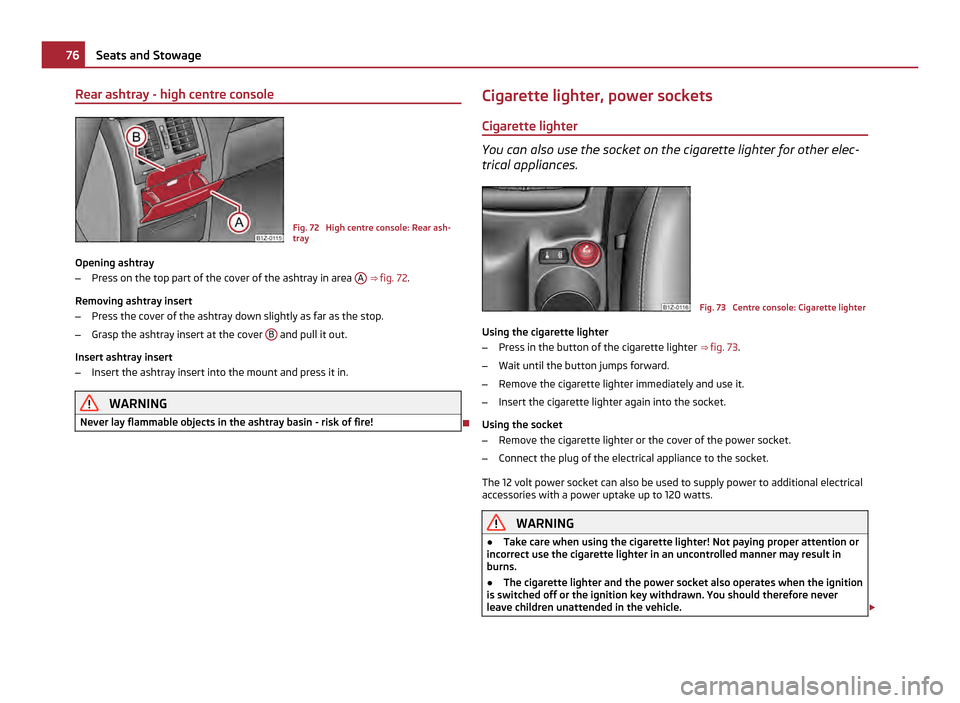
Rear ashtray - high centre console
Fig. 72 High centre console: Rear ash-
tray
Opening ashtray
– Press on the top part of the cover of the ashtray in area A
⇒ fig. 72.
Removing ashtray insert
– Press the cover of the ashtray down slightly as far as the stop.
– Grasp the ashtray insert at the cover B and pull it out.
Insert ashtray insert
– Insert the ashtray insert into the mount and press it in. WARNING
Never lay flammable objects in the ashtray basin - risk of fire! Cigarette lighter, power sockets
Cigarette lighter You can also use the socket on the cigarette lighter for other elec-
trical appliances.
Fig. 73 Centre console: Cigarette lighter
Using the cigarette lighter
– Press in the button of the cigarette lighter ⇒ fig. 73.
– Wait until the button jumps forward.
– Remove the cigarette lighter immediately and use it.
– Insert the cigarette lighter again into the socket.
Using the socket
– Remove the cigarette lighter or the cover of the power socket.
– Connect the plug of the electrical appliance to the socket.
The 12 volt power socket can also be used to supply power to additional electrical
accessories with a power uptake up to 120 watts. WARNING
● Take care when using the cigarette lighter! Not paying proper attention or
incorrect use the cigarette lighter in an uncontrolled manner may result in
burns.
● The cigarette lighter and the power socket also operates when the ignition
is switched off or the ignition key withdrawn. You should therefore never
leave children unattended in the vehicle. £76
Seats and Stowage